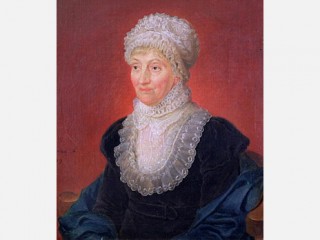
Caroline Herschel biography
Date of birth : 1750-03-16
Date of death : 1848-01-09
Birthplace : Hanover, Germany
Nationality : German
Category : Science and Technology
Last modified : 2011-01-28
Credited as : Astronomer, comet 35P/Herschel-Rigollet, sister of Sir Friedrich Wilhelm Herschel
Caroline Herschel is noted for her scientific annals in astronomy more than for her mathematical knowledge. Yet, while her accomplishments were heralded in astronomy, Herschel deserves recognition in both fields. She never received formal mathematical training, which only serves to accent the dimension of her accomplishments and determination.
Caroline Lucretia Herschel was born on March 16, 1750 in Hanover, Germany. She was a homely child who received little love and encouragement from her mother. Her father, Isaac Herschel, was a musician in the Hanoverian Guard. He encouraged her to obtain an education. She was, as he kept telling her, so homely and without money, no one would marry her until she was older and had more character. Herschel was a literate young woman, but did not receive a formal education. At the age of 17, her father died and she fell under her mother's domination.
Herschel led a harsh life until her brother William, who was eleven years her senior, empathized with her plight. He invited her to live with him in Bath, England, where he was immersed in musical training and astronomy. Their mother refused to let her go until William promised to provide funds for her mother to retain a maid.
In August 1772, Herschel left for England. Over the next five years, her horizons expanded. A neighbor taught her cooking, marketing, and English. Unlike their parents, William encouraged his sister to be independent. She enrolled in voice lessons and learned to play the harpsichord, soon becoming an integral part of William's musical performances at small gatherings.
In her spare time, she and William discussed astronomy. Her interest in the constellations grew. But, as William's sister, she needed to learn and incorporate English society into her schedule. Such activities seemed like nonsense to her staunch German upbringing, but she did learn with William's guidance, and soon began making appearances at the opera, theater, and concerts.
Herschel longed to be self-supporting. At the age of 27, she was in demand as a soloist for oratorios. But William increasingly needed her efficient, meticulous talents in copying his astronomy catalogs, tables, and papers. She eventually drifted from her desires and devoted herself to his astronomy.
Herschel assisted her brother in grinding and polishing his telescopes. He built a new six-foot telescope and began scanning the night skies. In 1781, William (with his sister's devoted help) discovered Uranus. This discovery assured him recognition in British scientific circles. Originally, Uranus had been named "Georgium Sidus," after King George III. William was appointed to the position of court astronomer and was knighted. While such an appointment guaranteed financial security for William, Caroline Herschel was appointed his assistant and given an annual stipend of 50 pounds. Herschel's appointment made her the first female in England honored with a government position.
Herschel focused on providing her brother with the support he needed. She systematically collected data and trained herself in geometry, learned formulas and logarithmic tables, and gained an understanding of the relationship of sidereal time (time measured by means of the stars) to solar time. Her record keeping was meticulous and systematic. The numerical calculations and reductions, which saved her brother precious time, were all done without error, and the volume of her work was enormous.
When Herschel was not engaged in other tasks, she too searched the night skies using a small Newtonian reflector. To her credit, in early 1783, Herschel discovered the Andromeda and Cetus nebulae. By year's end, she had discovered 14 additional nebulae. As a reward, William presented her with a new Newtonian sweeper of 27 inches, with a focal length of 30. Herschel was also the first woman to discover a comet. Between 1789 and 1797 she had discovered another seven comets.
Herschel calculated and catalogued nearly 2,500 nebulae. She also undertook the task of reorganizing John Flamsteed's British Catalogue, which listed nearly 3,000 stars. Herschel's listings were divided into one-degree zones in order for William to use a more systematic method of searching the skies.
Herschel's brother married in 1788, causing her concern about having to share his home and affections. These concerns proved to be without merit, as her new sister-in-law accepted her warmly and graciously. The two women became good friends.
On August 25, 1822, William died, leaving Herschel without support. She returned to Hanover, still supported by the British royal family. Herschel continued with her own work in the fields of mathematics and astronomy. In 1825, she had donated the works of John Flamsteed to the Royal Academy of Göttingen.
Herschel never married. She spent the last years of her life in Hanover, organizing and cataloguing the works of William's son, Sir John Herschel, who carried on his father's extensive work.
In 1828, at the age of 75, the Royal Astronomical Society awarded Herschel a gold medal for her monumental works in science. Ten years later, she was made an honorary member of the Royal Astronomical Society. She received a similar honor from the Royal Irish Academy. On her 96th birthday, Herschel was awarded the gold medal of science by the King of Prussia.
On January 9, 1848, Herschel died at the age of 97. Her meticulous work aiding her famous brother was her legacy. While not credited with any original mathematical works, she applied her painstaking, meticulous skill to the advancement of human knowledge.
Astronomy from A to Z: A Dictionary of Celestial Objects and Ideas, edited by Charles A. Schweighauser, Sangamon State University, 1991.
Dictionary of Scientific Biography, edited by Charles Coulston Gillispie, Charles Scribners' Sons, 1981.
















